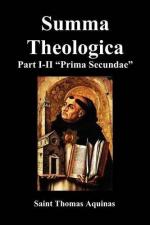Reply Obj. 1: A habit, considered in itself, is a simple form. It is not thus that it is subject to decrease; but according to the different ways in which its subject participates in it. This is due to the fact that the subject’s potentiality is indeterminate, through its being able to participate a form in various ways, or to extend to a greater or a smaller number of things.
Reply Obj. 2: This argument would hold, if the essence itself of a habit were nowise subject to decrease. This we do not say; but that a certain decrease in the essence of a habit has its origin, not in the habit, but in its subject.
Reply Obj. 3: No matter how we take an accident, its very notion implies dependence on a subject, but in different ways. For if we take an accident in the abstract, it implies relation to a subject, which relation begins in the accident and terminates in the subject: for “whiteness is that whereby a thing is white.” Accordingly in defining an accident in the abstract, we do not put the subject as though it were the first part of the definition, viz. the genus; but we give it the second place, which is that of the difference; thus we say that simitas is “a curvature of the nose.” But if we take accidents in the concrete, the relation begins in the subject and terminates in the concrete, the relation begins in the subject and terminates at the accident: for “a white thing” is “something that has whiteness.” Accordingly in defining this kind of accident, we place the subject as the genus, which is the first part of a definition; for we say that a simum is a “snub-nose.” Accordingly whatever is befitting an accident on the part of the subject, but is not of the very essence of the accident, is ascribed to that accident, not in the abstract, but in the concrete. Such are increase and decrease in certain accidents: wherefore to be more or less white is not ascribed to whiteness but to a white thing. The same applies to habits and other qualities; save that certain habits and other qualities; save that certain habits increase or diminish by a kind of addition, as we have already clearly explained (Q. 52, A. 2). ________________________
THIRD ARTICLE [I-II, Q. 53, Art. 3]
Whether a Habit Is Corrupted or Diminished Through Mere Cessation from Act?
Objection 1: It would seem that a habit is not corrupted or diminished through mere cessation from act. For habits are more lasting than passion-like qualities, as we have explained above (Q. 49, A. 2, ad 3; Q. 50, A. 1). But passion-like qualities are neither corrupted nor diminished by cessation from act: for whiteness is not lessened through not affecting the sight, nor heat through ceasing to make something hot. Therefore neither are habits diminished or corrupted through cessation from act.
Obj. 2: Further, corruption and diminution are changes. Now nothing is changed without a moving cause. Since therefore cessation from act does not imply a moving cause, it does not appear how a habit can be diminished or corrupted through cessation from act.




